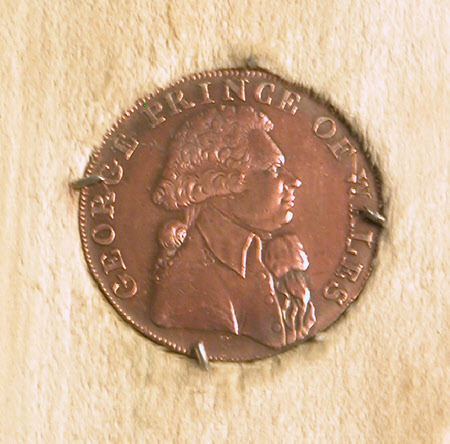A Brighton Camp halfpenny token
possibly Thomas Wyon Sr (1767 - 1830)
Category
Coins and medals
Date
1795
Materials
Copper
Measurements
29 mm (Diameter)
Place of origin
Birmingham
Order this imageCollection
Anglesey Abbey, Cambridgeshire
NT 517662.9
Summary
Copper, A Brighton Camp halfpenny token, Thomas Wyon (1767-1830) or another member of the Wyon workshop, Birmingham, 1795. A halfpenny token issued in 1795 for use in Brighton. On the obverse is a bust portrait of George, Prince of Wales (1762-1830) later George IV, in a frock-coat and bewigged, facing right. On the reverse is the heraldic badge of the Prince of Wales, with three ostrich feathers emerging from a coronet, and the legend ICH DIEN (“I serve”). Mounted in a frame with ten other medals and tokens commemorating and celebrating King George IV (1762-1830, reigned 1820-30) (NT 517662).
Full description
Tokens were issued periodically in the British Isles from the seventeenth through to the nineteenth centuries. Tokens are units of money used in substitution for the official coinage. They were generally produced to meet demand for small denomination coinage when there was insufficient official coinage in circulation. By the eighteenth century, tokens also began to be collected and so many were minted for the collectors’ market. This token is one of a group of three in the collections at Anglesey Abbey (for the others, see NT 517662.8 and 10), and carries a halfpenny denomination. Whereas one of the tokens in the group (NT 517662.8) was almost certainly made for collectors, the present example is a genuine trade token. It is one of a group of very similar tokens issued in 1794 and 1795, some examples of which are marked on the edge with an inscription indicating that they were intended for use in and beyond the army camp at Brighton. It may have been issued by a local tradesman Richard Maplesden, since one example of the 1794 token is recorded inscribed as for use at his premises in Winchelsea (Dalton and Hamer, p. 258, no. 39). King George IV is indelibly associated with Brighton, through the extraordinary Royal Pavilion, built for him over a period of several years, from around 1802 to 1823. However, he first visited Brighton, then the small fishing town of Brighthelmstone, in 1783, when he was Prince of Wales. It soon became a favourite place for the Prince, a bolthole away from his father and a place where he hoped the sea water treatments would help the ailments that were already afflicting him. From the mid-1780s the Prince would spend much time in Brighton with his morganatic wife Mrs Maria Fitzherbert, buying a small house that was successively restyled into the Marine Pavilion and, eventually, today’s Royal Pavilion. The town was already becoming a fashionable seaside resort, but the arrival of the Prince of Wales and his royal entourage quickly made it a beacon for high society, such that it quickly expanded and gained the nickname ‘London by the sea’. Prince George had many friends among the officers who, with their troops, much swelled the population of the town in the 1790s. Thus, his effigy and badge on a token made for use in the military camps in Brighton is entirely appropriate. Jeremy Warren, 2020
Provenance
Bequeathed to the National Trust by Huttleston Rogers Broughton, 1st Lord Fairhaven (1896-1966) with the house and the rest of the contents in 1966.
Credit line
National Trust Collections (Anglesey Abbey, The Fairhaven Collection)
Marks and inscriptions
Obverse: Legend: GEORGE PRINCE OF WALES Reverse: Motto: ICH DIEN Legend: HALFPENNY / 1795
Makers and roles
possibly Thomas Wyon Sr (1767 - 1830), medallist
References
Waters 1954: Arthur W. Waters, Notes on Eighteenth Century Tokens, London 1954, p. 28, nos. 2-5 Dalton and Hamer 1910-18, 1996: Richard Dalton and Samuel H. Hamer, The Provincial Token-Coinage of the 18th Century, 1910-18, edited by Allan Davisson, Cold Spring 1996, p. 254, no. 5 Withers 2010: Paul and Bente R. Withers, The Token Book. British Tokens of the 17th 18th and 19th centuries and their values, Llanfyllin 2010, p. 333, nos. 2-5
